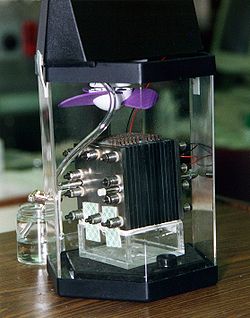Nishan_101
BANNED

- Joined
- Nov 23, 2007
- Messages
- 3,826
- Reaction score
- -18
Fuel cells powered by natural gas are an extremely exciting and promising new technology for the clean and efficient generation of electricity. Fuel cells have the ability to generate electricity using electrochemical reactions as opposed to combustion of fossil fuels to generate electricity. Essentially, a fuel cell works by passing streams of fuel (usually hydrogen) and oxidants over electrodes that are separated by an electrolyte. This produces a chemical reaction that generates electricity without requiring the combustion of fuel, or the addition of heat as is common in the traditional generation of electricity. When pure hydrogen is used as fuel, and pure oxygen is used as the oxidant, the reaction that takes place within a fuel cell produces only water, heat, and electricity. In practice, fuel cells result in very low emission of harmful pollutants, and the generation of high-quality, reliable electricity. The use of natural gas-powered fuel cells has a number of benefits, including:
Direct methanol fuel cell

Direct-methanol fuel cells or DMFCs are a subcategory of proton-exchange fuel cells in whichmethanol is used as the fuel. Their main advantage is the ease of transport of methanol, an energy-dense yet reasonably stable liquid at all environmental conditions.
Efficiency is quite low for these cells, so they are targeted especially to portable applications, where energy and power density are more important than efficiency.
A more efficient version of a direct fuel cell would play a key role in the theoretical use of methanol as a general energy transport medium, in the hypothesized methanol economy.
http://en.wikipedia.org/wiki/Direct_methanol_fuel_cell
These are projects on which KRL-GIDS, NESCOM and SUPARCO should work on. So that every home will only have a Natural gas line that will be able to produce the required electricity for home use and other than that it will going to save a lot of fuel(oil and gas) and water being wasted in power plants and also electricity wasted during transmission process.
So no need of wires with transformers and other support things only Natural gas fuel cell being fitted in homes and industries producing electricity directly from natural gas.
This will reduce infrastructure cost as only Water, Severage, Fiber Optics and Natural Gas lines will be laid in any city, village or county to fulfill daily needs.
- Clean Electricity - Fuel cells provide the cleanest method of producing electricity from fossil fuels. While a pure hydrogen, pure oxygen fuel cell produces only water, electricity, and heat, fuel cells in practice emit trace amounts of sulfur compounds and very low levels of carbon dioxide. However, the carbon dioxide produced by fuel cell use is concentrated and can be readily recaptured, as opposed to being emitted into the atmosphere.
- Distributed Generation - Fuel cells can come in extremely compact sizes, allowing for their placement wherever electricity is needed. This includes residential, commercial, industrial, and even transportation settings.
- Dependability - Fuel cells are completely enclosed units, with no moving parts or complicated machinery. This translates into a dependable source of electricity, capable of operating for thousands of hours. In addition, they are very quiet and safe sources of electricity. Fuel cells also do not have electricity surges, meaning they can be used where a constant, dependable source of electricity is needed.
- Efficiency - Fuel cells convert the energy stored within fossil fuels into electricity much more efficiently than traditional generation of electricity using combustion. This means that less fuel is required to produce the same amount of electricity. The National Energy Technology Laboratory estimates that, used in combination with natural gas turbines, fuel cell generation facilities can be produced that will operate in the 1 to 20 Megawatt range at 70 percent efficiency, which is much higher than the efficiencies that can be reached by traditional generation methods within that output range.

How a Fuel Cell Works
Source: DOE - Office of Fossil Energy
Direct methanol fuel cell

Direct-methanol fuel cells or DMFCs are a subcategory of proton-exchange fuel cells in whichmethanol is used as the fuel. Their main advantage is the ease of transport of methanol, an energy-dense yet reasonably stable liquid at all environmental conditions.
Efficiency is quite low for these cells, so they are targeted especially to portable applications, where energy and power density are more important than efficiency.
A more efficient version of a direct fuel cell would play a key role in the theoretical use of methanol as a general energy transport medium, in the hypothesized methanol economy.
http://en.wikipedia.org/wiki/Direct_methanol_fuel_cell
These are projects on which KRL-GIDS, NESCOM and SUPARCO should work on. So that every home will only have a Natural gas line that will be able to produce the required electricity for home use and other than that it will going to save a lot of fuel(oil and gas) and water being wasted in power plants and also electricity wasted during transmission process.
So no need of wires with transformers and other support things only Natural gas fuel cell being fitted in homes and industries producing electricity directly from natural gas.
This will reduce infrastructure cost as only Water, Severage, Fiber Optics and Natural Gas lines will be laid in any city, village or county to fulfill daily needs.
